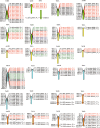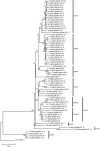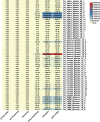Genome-wide identification, characteristics and expression of the prolamin genes in Thinopyrum elongatum
- PMID: 34852761
- PMCID: PMC8638145
- DOI: 10.1186/s12864-021-08088-x
Genome-wide identification, characteristics and expression of the prolamin genes in Thinopyrum elongatum
Abstract
Background: Prolamins, unique to Gramineae (grasses), play a key role in the human diet. Thinopyrum elongatum (syn. Agropyron elongatum or Lophopyrum elongatum), a grass of the Triticeae family with a diploid E genome (2n = 2x = 14), is genetically well-characterized, but little is known about its prolamin genes and the relationships with homologous loci in the Triticeae species.
Results: In this study, a total of 19 α-gliadin, 9 γ-gliadin, 19 ω-gliadin, 2 high-molecular-weight glutenin subunit (HMW-GS), and 5 low-molecular-weight glutenin subunit (LMW-GS) genes were identified in the Th. elongatum genome. Micro-synteny and phylogenetic analysis revealed dynamic changes of prolamin gene regions and genetic affinities among Th. elongatum, Triticum aestivum, T. urartu and Aegilops tauschii. The Th. elongatum genome, like the B subgenome of T. aestivum, only contained celiac disease epitope DQ8-glia-α1/DQ8.5-glia-α1, which provided a theoretical basis for the low gluten toxicity wheat breeding. The transcriptome data of Th. elongatum exhibited differential expression in quantity and pattern in the same subfamily or different subfamilies. Dough rheological properties of T. aestivum-Th. elongatum disomic substitution (DS) line 1E(1D) showed higher peak height values than that of their parents, and DS6E(6D) exhibited fewer α-gliadins, which indicates the potential usage for wheat quality breeding.
Conclusions: Overall, this study provided a comprehensive overview of the prolamin gene family in Th. elongatum, and suggested a promising use of this species in the generation of improved wheat breeds intended for the human diet.
Keywords: Celiac disease; Evolution; Expression; Prolamins; Thinopyrum elongatum.
© 2021. The Author(s).
Conflict of interest statement
The authors declare that they have no competing interests.
Figures






Similar articles
-
Characterization of a wheat-tetraploid Thinopyrum elongatum 1E(1D) substitution line K17-841-1 by cytological and phenotypic analysis and developed molecular markers.BMC Genomics. 2019 Dec 10;20(1):963. doi: 10.1186/s12864-019-6359-9. BMC Genomics. 2019. PMID: 31823771 Free PMC article.
-
Molecular Characterization and Marker Development of the HMW-GS Gene from Thinopyrum elongatum for Improving Wheat Quality.Int J Mol Sci. 2023 Jul 4;24(13):11072. doi: 10.3390/ijms241311072. Int J Mol Sci. 2023. PMID: 37446250 Free PMC article.
-
New insights into structural organization and gene duplication in a 1.75-Mb genomic region harboring the α-gliadin gene family in Aegilops tauschii, the source of wheat D genome.Plant J. 2017 Nov;92(4):571-583. doi: 10.1111/tpj.13675. Epub 2017 Oct 9. Plant J. 2017. PMID: 28857322
-
Use of wild relatives to improve salt tolerance in wheat.J Exp Bot. 2006;57(5):1059-78. doi: 10.1093/jxb/erj124. Epub 2006 Mar 2. J Exp Bot. 2006. PMID: 16513812 Review.
-
Utilization of blue-grained character in wheat breeding derived from Thinopyrum poticum.J Genet Genomics. 2009 Sep;36(9):575-80. doi: 10.1016/S1673-8527(08)60149-6. J Genet Genomics. 2009. PMID: 19782959 Review.
Cited by
-
Recent duplications and rare structural variations revealed by comparative sequence analysis of low molecular weight glutenin subunits (LMW-GS) genes re-identified using LMWgsFinder in 26 genomes of the grass family.Theor Appl Genet. 2025 May 27;138(6):128. doi: 10.1007/s00122-025-04919-7. Theor Appl Genet. 2025. PMID: 40425835
References
-
- Shewry PR, Halford NG, Lafiandra D. Genetics of wheat gluten proteins. Adv Genet. 2003;49:111–184. - PubMed
-
- Wieser H. Chemistry of gluten proteins. Food Microbiol. 2007;24:115–119. - PubMed
-
- Payne PI, Holt LM, Lawrence GJ, Law CN. The genetics of gliadin and glutenin, the major storage proteins of the wheat endosperm. Plant Foods Hum Nutr. 1982;31:229–241.
-
- Payne PI, Corfield KG. Subunit composition of wheat glutenin proteins, isolated by gel filtration in a dissociating medium. Planta. 1979;145:83–88. - PubMed
Publication types
MeSH terms
Substances
LinkOut - more resources
Full Text Sources
Miscellaneous

